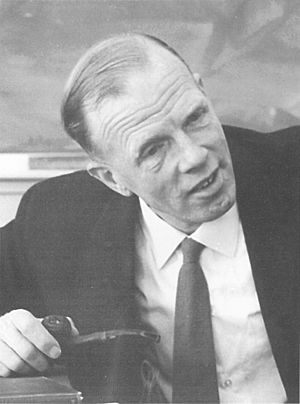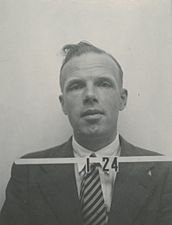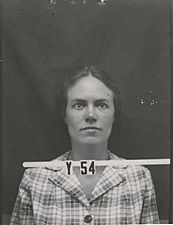Philip Burton Moon facts for kids
Quick facts for kids
Phlip Burton Moon
|
|
|---|---|

Moon in Los Alamos in 1964
|
|
| Born | 17 May 1907 Lewisham, London, England
|
| Died | 9 October 1994 (aged 87) |
| Alma mater | Sidney Sussex College Cavendish Laboratory |
| Known for | Tube Alloys Manhattan Project Gamma ray fluorescence development of atomic bomb 'Oliphant's satellite' |
| Awards | Hughes Medal (1991) Fellow of the Royal Society |
| Scientific career | |
| Fields | Nuclear physics |
| Institutions | University of Cambridge Imperial College, London Birmingham University Cavendish Laboratory University of Birmingham |
| Doctoral advisor | Ernest Rutherford |
| Other academic advisors | Sir Mark Oliphant |
| Doctoral students | Noor Muhammad Butt |
| Influenced | James Chadwick |
| Signature | |
Philip Burton Moon (17 May 1907 – 9 October 1994) was a British physicist. He is known for his important work in atomic physics and nuclear physics. Moon was one of the British scientists who helped with the Manhattan Project in the United States. He also worked on Britain's Tube Alloys project. These projects were about developing new technologies during World War II.
Contents
Early Life and Education
Philip Burton Moon was born in 1907. He went to Leyton Sixth Form College. In 1925, he started studying at Sidney Sussex College, Cambridge. He became a research student at the Cavendish Laboratory. His teacher there was the famous scientist Ernest Rutherford.
Working at Cavendish Laboratory
From 1928 to 1931, Moon worked with Mark Oliphant. They studied how tiny particles called atoms interact. Rutherford, their teacher, even called Moon "Oliphant's satellite." This shows how much Oliphant influenced Moon's work for many years. Moon continued to work at Cavendish Laboratory in the mid-1930s. He shared a room with Mark Oliphant. Later, both scientists moved to the University of Birmingham. Moon joined the university in 1938.
World War II Contributions
During World War II, Philip Moon was part of the MAUD Committee. This group confirmed that it was possible to create an atomic bomb. After this, he joined the British team that worked on the Manhattan Project in the United States. One of his jobs was to design tools. These tools would measure the results of the first atomic bomb test.
His wife, Winifred Moon, also worked at Los Alamos. This was the main research site for the Manhattan Project.
Career at Birmingham University
After World War II, Moon became a professor at Birmingham University in 1946. He took over from Mark Oliphant. He held this important position until 1973.
In 1950, Moon was the first person to find gamma ray fluorescence. This is a special way that gamma rays interact with materials. It took several years for his findings to be fully proven.
In 1975, Moon was honored by the Poynting Physical Society. He was made their honorary life president. In 1991, the Royal Society gave him the Hughes Medal. This is a very important award for scientists.
His scientific papers and notes are kept at the University of Birmingham. You can find them in their Special Collections.



